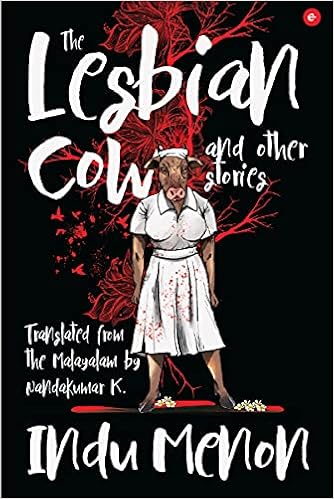
Suhasini Patni is a freelance writer based in Jaipur and Delhi. Currently, she is working on her postgraduate degree in linguistics at the University of Rochester, New York. Website.
The Lesbian Cow and Other Stories by Indu Menon; Translated by Nandakumar K. | EKA Westland, India | July 12, 2021
Reviewer: SUHASINI PATNI

“Indu Menon’s stories are not for the fainthearted,” warns Nandakumar K, the award-winning translator of The Lesbian Cow and Other Stories in his foreword. “Her women know that no avenging angel will be there for them, nor any fairy godmothers. They can only rely on themselves.” Every story in the collection is graphic, unsettling the stomach with its blend of graceful momentum and poetic sentences describing gory details of torture inflicted on the physical body. Each one leaves the reader with a slight sense of intoxication, startling in its intensity and “terrible beauty.”
In the first story, titled ‘The Creature’, a man—dark, hairy, and likened to an animal—is tortured on the command of Big Bro. Amorinderjeet Gupta, the “youngest child in a middle-class family” has been organizing the torture by kicking and striking the man, and drenching him in water pulled out of a commode. The splotchy, bloodied body lies there, unmoving yet undead. Amor is asked to shoot a pornographic film, converting the lifeless body into one overcome by the throes of passion. A seventeen-year-old girl, with full lactating breasts, and a mole on her face, arrives to shoot the film. The Creature is undergoing this torture because he was going to testify against Big Bro for illegally buying Adivasi land for mining. Basudhera, the young woman, discovers the truth about The Creature’s identity. A lifetime ago, she had known him in her village, where people now believe that she is dead.
“In the Gondi River, Basu was once lying half-dead, swept away by the torrents. Nana rescued her, greedy for the lifeless body of a young woman.”
The young woman who had suffered torture and rape at the hands of those same men, now makes love to The Creature with a seamless beauty. When they watch her on screen later, they are mesmerized. Amor falls at her feet, asking to be made love to in the same way. “How many girls have you destroyed?” she asks him. She hides a lethal blade in her genitals, letting him enter her, only to find the perfect moment to annihilate him.
It would be a simplification to say that Menon’s female characters do not go down without a fight. Sometimes, even at the cost of their own lives, they fight back. However, Menon plays with the archetypal feminist revenge fantasy trope. Most of her stories begin with a male voice; the reader observes the woman character like a spectator, free to make judgments of their own about her. In ‘The Bloodthirsty Kali’, Kamala avenges the rape and death of her older sister by letting the Goddess Kali take over her body. She sprinkles seeds on her victims, and the next day they wake up feverish with blisters all over their skin, their flesh popping like mustard seeds sautéed in a hot pan. In ‘Premasutra’, a womanizer has sex with a woman thirty years his junior. Later, he finds out that she is the daughter of the woman to whom he had lost his virginity. This inflates his ego; he has had sex with both mother and child. But his old lover confesses that her daughter was born of their love affair. That he has been a father all this while, and now he’s committed incest. His daughter commits suicide, and the womanizer never has sex again.

However, the shock of these stories diminishes soon enough. It seems as if Menon’s aim is to make one numb to what inspires shock. Instead, she lets the reader revel in the beauty of desire and warmth. In ‘Virgins Who Walk on Water’, there is a tender love between Amuda and Raziya, a same-sex couple who conceive a child through IVF. Tender moments are rare in the collection, much like in real life. Quiet and sublime snatches of time in the midst of unforgiving pain—these are the pivotal moments the writer wants to shock us with.
Menon’s work has been placed within the feminist tradition of Kamala Das: frank, daring, and explicit. But in an interview with Kitab Khana Books, K. Jayakumar diminished this comparison, calling her far more audacious than any other writer before her. “Unpredictability is the hallmark of Indu as a writer. When Indu Menon writes a story, Kerala listens. She writes about a reality that is more real than real. It is a hyper-reality,” he said. Nonetheless, readers who have enjoyed the works of Kamala Das, Mahasweta Devi, and even Meena Kandasamy, will find excitement and pleasure in Menon’s stories. Her short stories have won the Kerala Sahitya Akademi award, among others. She has also written two novels and is known for her use of magical realism to blend the aesthetic and gory.
Through characters inhabiting diverse milieu—a barren married woman, a female fighter in the Liberation Tigers of the Tamil Eelam, an actress who is taught to compromise on her bodily autonomy—Menon explores what it’s like to be on the periphery. In ‘Muslim with Hindu Features’, a Muslim fish-seller falls in love with a Hindu woman. She only finds out about his religion when she asks him his name.
“Are you a Muslim?” she asked.
He could see darkness creeping into her pale face. He was staggered by the change in her expression.
“You don’t look like a Muslim.” Her voice was cracking up. “You deceived me.” Disappointment filled her eyes. Her kohl ran and spread.
Yet, Mustafa, the Muslim man who looks Hindu, is united with Ahalya, who confesses she cannot live without him. A prohibition order is imposed at the beach where he sells fish. Policemen seek out the couple, torturing Mustafa, accusing him of storing weapons. He stands his ground until he finds out his lover Ahalya has been raped and has given birth to the policeman’s baby. He is so distraught he agrees to confess to anything. Menon often writes about the growing intolerance against Muslims in her collection. It’s important to note, then, that the publication year of the original Malayalam collection was the same as that of the Gujarat Hindu-Muslim riots.
Shifting from the underbelly of villages to military camps in Sri Lanka, or from forced sterilization camps during the Emergency to seedy motels, riverbanks, lecture halls and hospitals, this collection traverses all possible paths. Menon might repeat some of her motifs. The potent image of the leaking, lactating breast bespeckles almost every story. If cancer appears, it is always of the breasts that, ultimately, need to be cut off. There is heavy detail about each character’s face and, often, skin color. Menon’s stories show us the ugliness of the world in highly concentrated forms. Their shocking nature is due to transgressions of both fiction craft and politics. Overall, the primary effect is that of unpredictability. She challenges the very core of outdated, demure femininity, forcing the reader to confront their foundational beliefs of what a woman should and can do. Her uncomfortable prose aims to to trigger a response toward a widespread, and largely unacknowledged, violence. It’s unconcerned with fairness. A first read may make the reader feel jittery and convulsed, but ultimately one realizes the stories are exploring an untapped anger. A bold and evocative anger that provokes one to question shock itself.
Back to #DesiBooksReview Issue 1


Suhasini Patni is a freelance writer based in Jaipur and Delhi. Currently, she is working on her postgraduate degree in linguistics at the University of Rochester, New York. Website.
